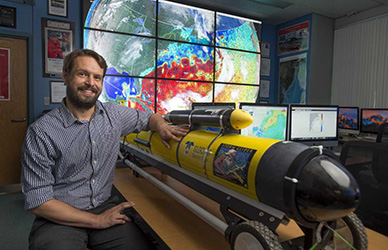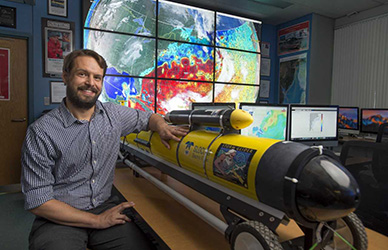The award reflects Miles’ work using ocean sensory technology to understand hurricane intensity and determine the ocean’s role in modulating hurricane energy.
By Carol Peters

EOAS faculty member Travis Miles.
The Marine Technology Society (MTS) has named Travis Miles, a faculty member in the Rutgers Institute of Earth, Ocean, and Atmospheric Sciences (EOAS), the recipient of the 2018 Ocean News and Technology Young Professional Award.
The award, according to the MTS website, “is presented to an individual 35 years old or younger who . . . has shown leadership in MTS and who works in a professional capacity in management, engineering or research and development in a marine technology field.”
Miles, an assistant professor in the Rutgers Center for Ocean Observing Leadership (RU COOL) in the Rutgers University-New Brunswick Department of Marine and Coastal Sciences (DMCS), said, “Our team at Rutgers is pioneering research on the ocean’s role in determining the intensity of hurricanes by deploying underwater gliders (robots) right into the ocean during storms. This enables us to collect samples we wouldn’t be able to obtain otherwise. We are the first early adopters of this technology, and I received the MTS award for this core reason.”
The data Miles is collecting are being used to improve ocean models, to use in conjunction with atmospheric models, in order to create more accurate forecasts to better predict the intensity of hurricanes as they approach coastlines.
This research will benefit every person who lives near any coast across the globe, and the number of people who live on the world’s coasts is increasing every year. “The growing population along coasts coupled with sea level rise will have continued impacts. In other words, the same intensity of storm will have a greater impact given sea level rise combined with the number of people living on the world’s coasts. The first line of defense is accurate forecasts,” Miles said.
“Hurricanes obtain energy from the ocean, so we need to develop a deeper understanding of how the ocean and atmosphere interact during storms. Researchers can’t go out into the ocean during hurricanes and take samples, so we deploy underwater robots right into storms to take the samples we wouldn’t be able to obtain otherwise. Our gliders measure the temperature and salinity of the ocean water and send the data back in real time every two or three hours. So we can sit in the lab during a hurricane and see what’s happening in the ocean in real time.
“Researchers have previously thought that the ocean changes over days to weeks in storms, but we see it change in hours. The ocean has significant impacts on weather and atmosphere in short time periods.”
Miles’ former Ph.D. advisor and current colleague Rutgers Distinguished Professor Scott Glenn nominated Miles for the award. Explaining the significance of this honor, Glenn said, “This is an international award given to only one young professional member of MTS per year.”
He nominated Miles for the award, Glenn said, because “Travis is a great example of the international prestige our EOAS young investigators bring to Rutgers. Travis continues to develop new underwater glider technologies for observing severe storms. This has enabled him to identify two rapid and distinct coastal ocean responses that feedback on tropical storm intensity forecasts. These results provided U.S. government agencies working to improve the ocean component of hurricane forecasts the ‘irrefutable’ scientific evidence and the ‘sound’ technological approach to justify a fundamental shift from responding to hurricanes to preparing for hurricanes. The collaborative fleet of sentinel glider picket lines deployed this past hurricane season demonstrated its value in Hurricanes Florence, Isaac, Helene and Michael, as well as in Typhoon Soulik.”
Miles’ journey on his current professional path began in 2009 when he interviewed with Glenn for a spot in the Rutgers Ph.D. Program. During his initial interview with Glenn, Miles said, “We discussed whether we could fly a robot into a hurricane in the ocean. The decision that we could do this led to my coming to Rutgers. We have achieved this since then, and it’s been massively successful.”
Miles and Glenn put the robot out into the ocean right before Hurricane Irene and Superstorm Sandy hit, Miles said, and the data they gathered during Sandy became the subject of Miles’ doctoral thesis.
The research they conducted during Hurricane Irene was ground-breaking, Miles said, and it led to a paper Glenn and Miles published in the journal Nature. “In the Mid-Atlantic, the region between Cape Cod and Cape Hatteras, there is a cold-water mass, called a cold pool. Irene mixed the cold pool at the bottom of the ocean with the warm water at the ocean surface that was feeding the hurricane and thus reduced the intensity of the hurricane by a category. Our robot, the glider, discovered this.”
Superstorm Sandy was different, Miles explained. While Irene cooled the ocean water at the surface and thus caused a deintensification of the storm, Sandy made a left hand turn as it was making landfall. “We deployed a glider in rapid response to Sandy. Four or five days before Sandy was predicted to make landfall we deployed the glider to sample the ocean water under Sandy. The winds were blowing in different directions and we took this opportunity to better understand how ocean physics works. In the case of Sandy, the cold water got pushed offshore into the deep ocean, so it was not available to be mixed with warmer water which would have decreased the storm’s intensity. In addition, Sandy hit later in the season and came from a different angle which made it different from Irene.
“Storms are named, they have distinct personalities, and they interact with the ocean differently. The data we are collecting will help us understand each storm and build accurate ocean forecast models to use with the atmospheric models in order to discover the storm intensity problem.”
Next steps in Glenn’s and Miles’ research are to further interact with the National Oceanic and Atmospheric Administration (NOAA)and in labs at the U.S. Navy to ensure the data they are acquiring is incorporated in operational forecast models. Their work therefore is transitioning from research to operations. “We are getting a lot of support and many endorsements from the leadership in NOAA and the U.S. Navy,” Miles said. “These groups are adopting our strategies.”
Miles and Glenn are also conducting research with partners at other academic institutions through the Integrated Ocean Observing System (IOOS), which is a NOAA body that coordinates the regional body and observation into a single unit, Miles said. “We have support, not necessarily just funding, but we have established solid operational support by working with other academic institutions, including the University of Delaware, the Virginia Institute of Marine Science, the University of Massachusetts-Dartmouth, the University of Maryland, the University of Puerto Rico, the University of the Virgin Islands, the University of Georgia, and many others. Texas A&M and the University of Mississippi are our partners in the gulf. A huge portion of the United States is interested in hurricane impacts. Hurricanes aren’t just hitting Florida anymore. There is a lot of buy-in for developing solutions.”
Working on acquiring new and more advanced sensors to be able to better look at the physics of the ocean during storms, Miles said, is another area they are focusing on. “We are building the next generation of models that can help us use the data in real time. If we build the research on the physics processes, we will end up with a better forecast.”
In addition to his cutting-edge research, Miles said he also received the MTS award for other ways he has contributed to MTS. Miles explained he has been very active in the society by giving trainings and talks, and by involving Rutgers undergraduate and graduate students in his research.
Students work in his lab doing glider deployments and recoveries, Miles said. He and Glenn are very dedicated to teaching undergraduate, masters and doctoral students about these technologies, he said, because “It’s very expensive to take students to sea, but Rutgers wants to make sure students have this experience, so we ‘take them out to sea’ digitally with computers in one class we teach. This greatly aids their understanding, and we need more students to work with the technology and understand the data.”
They teach this class in an engineering lab in DMCS, but Miles said the course also includes a “boat day” on the Raritan Bay. There they demonstrate to the students how to launch a glider in the bay and then how to take it out of the water. “By teaching the next generation of researchers about the ocean robots we will move the technology forward,” Miles said.
In another contribution to MTS, during this year’s conference, Miles said he and his colleagues started an “unmanned untethered vehicle” committee that will cover research about the technologies that fall broadly into this category, such as gliders, airborne drones, and other technologies. Miles is a member of the committee and has volunteered as co-chair for the glider portion.
“We’ve been working in stove pipes, so the goal of the committee is to work together to see what we can learn within one autonomous system to improve other technologies. To be able to increase communication across our different groups makes it all very exciting.”



